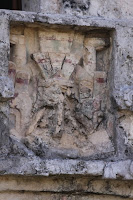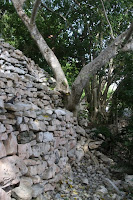
Looking southeast from our hotel's main building. Our cabin is the first in the foreground.

Our home sweet home, cabin 3. It is a porch with a roof, and under the roof is a giant army-style tent with screened windows. There is no electricity and the bathrooms and showers are shared. We heard nothing in our cabin except the noise of the ocean and the wind. The sun rising over the ocean woke us every morning. It was heavenly.

Looking southwest from our hotel. The lagoon boat trip took us back into the areas on the right side of the photo and up the shore on the left side of photo. The lagoon is a lovely greenish color and very different from the intense turquoise-and-teal of the ocean.

Looking northwest (more or less) from the hotel's main building. You can see small hummocks of ground that are rare oases of solid ground in the lagoon and in the mangrove swamp.

This is our hotel's main building as seen from the lagoon side.

The lagoon is filled with wildlife. During winter migration about 20 million birds cross the peninsula, and about 1 million stay. The guide says there are 373 species of birds in the area. This is an osprey - a sea eagle.

We took a boat tour of canals and rivers across the lagoon from our hotel. The lagoon and the first stage of the mangrove is brackish water (high salt). It changes to a much lower degree of saltiness about 1/3 of the way up the short "river," and becomes more or less freshwater at the head of the river. The vegetation changes pretty dramatically at each transition: the saltwater mangrove is mostly the stunted trees, the mixed water mangrove is odd-looking mangrove trees with grass growing between them, and the freshwater mangrove is a treacherous swamp made mostly of sawgrass that won't support the weight of a person. There are pools of quicksand scattered throughout, and occasional hummocks (like in the Everglades) with solid land and palm trees. Mangroves are cool anywhere, and these were no exception.

Saline mangrove.

Self-portrait with spouse and gear.

Go go Gadget camera! Ian likes funky cameras now!

It was beautiful. The water really is that color, and so fresh and cool it was hard to believe. This is looking upstream and away from the family of six teenagers who spent the entire drift shrieking and squealing about things touching them. Ian suggested at one point that he might start yelling about something getting him to see what they'd do, but cooler heads prevailed.

The mangrove is thick with orchids like this one and bromeliads. The bromeliads are not as photogenic as the orchids, but the guide was very excited about them and spent quite a bit of time explaining them and their adaptations to us.

This is Boca Paila - the spot where our lagoon system meets the Caribbean.

We saw a pelican who didn't care at all about our motorboat. There are lots of pelicans in the Yucatan.

And another pelican!

And a cool speckled bird that really wanted its photo taken!

And a crocodile!

At slightly more than half done with the holiday, Ian was refreshed and happy.

At slightly more than half done with the holiday, I was tired and happy.
-----

The Yucatan Peninsula is made of limestone and is basically flat. There are no above-ground rivers through most of it because water seeps through the limestone and finds the ocean through underground rivers. In places the water forces its way to the surface in fresh-water pools called "cenotes" (say-NO-tays). We visited one called Dos Ojos (Two Eyes) and had a dip. After the warm ocean, the water was very, um, refreshing. Some cenotes are in caves, some are partially covered (like these), and others are open. The water is fresh and can be drunk after purification.

Water-baby Ian is not worried about the water and went with the guide into a closed, back cavern. I elected to stay where there's plenty to breathe and provided the mosquitoes with a light snack before joining Ian again for a less threatening part of the tour.

"Dian" and "Moniki" in a couples picture. Our names cause Spanish speakers trouble at the best of times, and our guide was a Spanish-as-a-second-language speaker. He is Maya, and he speaks Maya, and "Ian" and "Moli" was just too much for him.

Look, ma! I've got my face in the water! I've also got a kickin' new snorkel shirt that inflates on the front. It's like lying on a short air mattress, and it's a vast improvement over the lifejacket I used previously.

An artist's rendition of what Tulum must have looked like - at least partially - back in the day.

El mundo maya and the important cities and routes.

Tulum was a major port and had an important lighthouse to help the Maya get across the Yucatan Peninsula's barrier reef.

Looking in at what was the city. It's hard to imagine it all paved and painted and crowded with businesses!

The "descending god" (sunset) was worshiped at Tulum. You can see his feet in the upper corners of this carving.

Tulum is not fully excavated and trees are still growing through the walls. I love that.

Can you spot the iguana? Hint: it's only a tail....

Sunset over the lagoon. The sun sets around 7.25 in the Yucatan right now, and at about 7.31, hordes of vicious mosquitoes who don't care at all about bug spray - biodegradable or otherwise - attack anyone who's not sitting in a stiff wind. After the first night, we took the precaution of informing the waiter that we would take drinks on the sunset side and take dinner on the ocean side where there was a strong and steady wind!

No comments:
Post a Comment